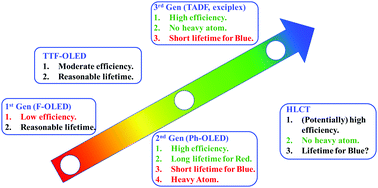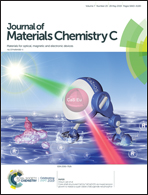Blue organic light-emitting diodes: current status, challenges, and future outlook
Abstract
The recent progress of efficiency improvement, emission color tuning, and lifetime elongation of blue organic light-emitting diodes (OLEDs) is reviewed. The latter is one of the most important bottlenecks for OLED development. The current status of blue light-emitting material design with emission mechanisms such as fluorescence (F), phosphorescence (Ph), thermally activated delayed fluorescence (TADF), and hybridized local and charge transfer (HLCT) is introduced in the first part of this review. Compared to red and green devices, the long exciton lifetime of the high energy triplet exciton in a blue OLED is the one of the main issues. To avoid the accumulation of high energy triplet excitons in the emitter for blue OLEDs, assisted triplet–triplet fluorescence (TTF) and Hyperfluorescence™ are employed to harvest the triplet excitons. In the second part of this review, we focus on issues from an application viewpoint: what are the requirements of blue OLEDs for display and lighting technologies in terms of efficiency, color, and lifetime? Key performance metrics of blue OLEDs with different technologies over time are summarized. Independent of technology, the trend is similar: the external quantum efficiency improves for the first stage of research, followed by color tuning, and then finally lifetime elongation. The state-of-the-art device performance of blue OLEDs with various emission mechanisms is illustrated. Although Ph- and TADF-emission based devices show satisfactory efficiency and electroluminescence (EL) spectra, despite having a lower efficiency TTF-emission based devices are the mainstream for real applications due to their relatively long operation lifetime. Blue Ph-OLEDs have the potential for lighting applications with suitable material selection and device design. We collected the published results and tried our best to make a fair comparison of the operation lifetime among different technologies. Finally, we discuss the possible future outlook from different viewpoints including new materials, device designs, and applications of blue OLEDs.

- This article is part of the themed collection: Recent Review Articles


 Please wait while we load your content...
Please wait while we load your content...